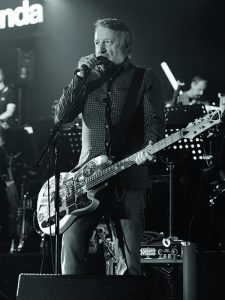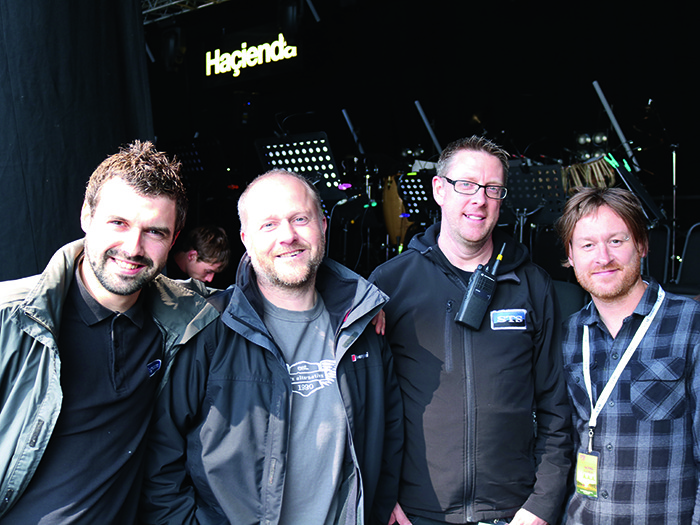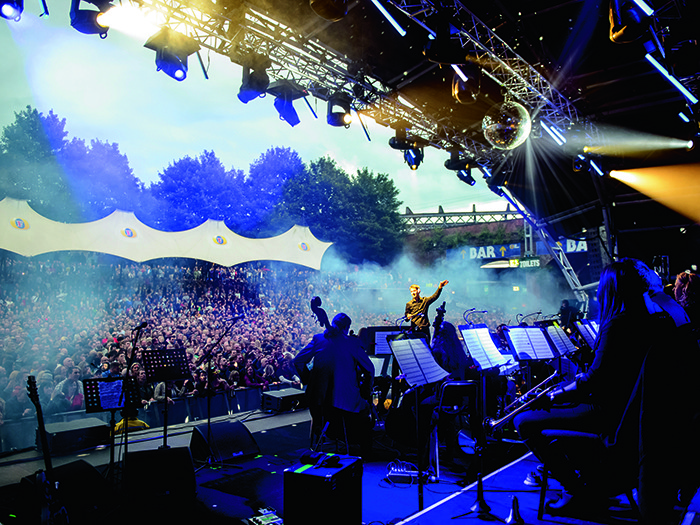When rave instigators from the Haçienda’s glory days teamed up with the Manchester Camerata Orchestra, legions of dedicated fans were promised a fresh take on the biggest tracks of the acid house movement. The benefits of creative collaboration were seen both on stage and backstage amongst the suppliers working on the show at Manchester’s Castlefield Bowl. TPi heads to the hometown gig to talk nostalgia, club music and the success the shows had enjoyed.
For those who remember the ascendency of acid house, bolstered by acts such as New Order and Happy Mondays, the name Haçienda still resonates as if the deep basslines play on. It has been almost two decades since this famous venue in Manchester city centre closed its doors to dancers and ravers. The building still stands today, although now in the corporate guise of an apartment block. The role the Haçienda played in British rave culture has not been forgotten, and the name has enjoyed longevity far exceeding the venue’s lifespan. So, when it was announced that DJs from the club’s heyday would return, the old vanguard – who have long since retired their flourescent shirts and whistles – sat up and took notice.
Haçienda Classical saw the DJs join forces with a live orchestra, combining the contemporary with the classical in an unusual twist all under the watchful eye of New Order’s Peter Hook who took on the role of Event Producer. As the Haçienda is born and bred Mancunian, who better to collaborate with the Manchester Camerata? The run of shows began in the venue’s hometown in February with a night at the Bridgewater Hall that sold out in minutes. The group of classical musicians and DJs played nights across the UK including the Royal Albert Hall in London. TPi caught up with the team behind this bizarre but beautiful culture-clash at the Castlefield Bowl, in front of a sold out crowd of 8,000, for the Sound of the City concert series, promoted by SJM. The series included headline sets from James Bay, Stereophonics, Catfish and The Bottlemen and Guy Garvey.
Come Together
The man taking on the task of bringing together two worlds was Production Manager, Matt Jones. Pre-show, he talked about how he first encountered the project. “It’s safe to say that during the early days, no one really understood how much of an undertaking this project would be. I entered the picture after Joel Perry [Account Manager at Wigwam] got in touch to ask about my availability. As well as Production Managing I have a lot of experience in audio, working as monitor engineer for Pixies for the best part of 11 years, as well as freelancing for Wigwam on various occasions.” Matt credited his ongoing professional relationship with Tom Bush [Wigwam’s Project Manager] for securing the contract adding: “All the Wigwam guys knew that there needed to be a production manager with a real knowledge of audio due to the demands of this show.”
With Matt in place, the next challenge for the PM was to fuse the polarities of classical and club music. “Honestly, compared to my other production managing jobs, this has easily been my most challenging show. There really is a clash of ideologies with the chaos of the Haçienda and the very strict structure of the orchestra. I love the chaotic aspects of the Haçienda crew as I think that is what makes their show so good, but at the same time the structure of the orchestra really gives the show its power. It demands a really delicate mix. For example, the orchestra only have a finite amount of time they can adhere to. During rehearsals we could never could go over the timeslot allotted as any overtime meant £15 per head in the orchestra every 15 minutes. When dealing with a 70-piece orchestra you can understand why organisation had to sometimes reign supreme.” But according to Jones, all the hard work is more than worth it: “There are some amazing looks during this show. We are coming into the traditional ‘classical’ settings and bringing back the club aesthetic. It really is something special.”
The show at Castlefield Bowl had some additional logistical issues, as it’s an open-air venue in the middle of the city centre. “There are tight curfew laws which makes sense when you look at the location,” explained Matt. “The only times we can make noise is between midday and 2pm! This meant coming in early this morning so we were ready to go by midday, no matter what. We have a private company constantly taking measurements to ensure we don’t exceed the limits.”
Can U Dance?
The live mixing of a classical orchestra with a foreign genre is hardly a new concept. Many acts draft in an army of brass and string players to add new depth to their material. In fact, Wigwam was brought into the project at least in part due to its experience dealing with orchestras. But despite the company’s expertise, this show still presented a challenge for the audio specialists. Matt explained: “Just for audio control we had to bring in seven people. For this show we also had added complexity as this was the first time we had complete changeovers with four DJs, including Mike Pickering and Graeme Park, as well as 808 State playing sets. There are a lot of moving parts on stage!”

FOH Engineer, Steve Jones to talked through the control package: “We have one desk that mixes the orchestra, manned by Jonathan Digby [also the show’s System Designer] although for this show we have Jon Brooks covering for him. He sends me groups of the orchestra to my desk. So I have control of each of the groups that I mix together with the DJ tracks, backing tracks, choirs, bass and the several live singers that we have coming in on some tracks.” Digby had specified a DiGiCo SD7 for the orchestral element, while Steve was provided with an SD9.
Steve explained one of the hardest jobs during this show was to find the balance between the club mix and the orchestra: “There is almost a slight division within the crowd. On the one hand there are those simply curious what the mash-up would sound like, and on the other, the hardcore Haçienda fans who just wanted to go mental. It’s a case of people still getting the club feel while keeping the kick-drum in the mix alongside the DJ scratching and still ensuring the orchestra is ever present.” Steve wished to complement the legendary DJs that shaped the Haçienda sound, Mike Pickering and Graeme Park, who created a set list that crescendoed as the night went on: “The way they organised the set list is very much like a club. It starts slow with three bpm changes throughout. Nearer the end it gets pretty full on until it really starts to feel like the old days at the Haçienda!” The Haçienda team were certainly very involved in all elements of the production. Co-founder, Peter Hook, even stands at FOH with Jones during the shows. Steve enthused: “He knows the songs inside out and the cues and what should be happening in the mix. He used to do sound for a couple of bands back in the day and still does a bit of producing. He’s a very knowledgeable guy.”
Although Wigwam was the audio supplier for the tour, as the Castlefield Bowl show was one of several gigs that week at the site, the supplier only needed to provide a control package, with a PA system already in place courtesy of Adlib. The PA consisted of 16 L-Acoustics K1 boxes along with four ARCS, 16 KARAs and a sub section of 16 L-Acoustics SB28’s and two SB18’s. For side hangs 12 L-Acoustics K2 speaker boxes were used.
Ride (The Faders) On Time
One of the biggest issues that the audio team faced was the sheer number of microphone channels needed to pull off this show. Taking up the story was Robert McCourt, Stage Tech for Wigwam. “For the Castlefield show we only have 40 musicians that all have to mic’d up, but for our first show we rolled out a 70-piece orchestra which ended up using 104 channels. With such a large channel count, simply dealing with feedback creates a lot of stress but I think we have got it down now.” McCourt explained this was one of the benefits of the Castlefield Bowl set; the lack of a roof gave the ability to push the audio more than in previous shows. “The high intensity of this show was one of the reasons I was so keen to work it,” concluded McCourt. “If you have one microphone on stage that doesn’t work you have to be out there in 20 seconds flat. I found the challenge pretty cool.”

Jones was very quick to praise the prowess of his audio team. “It’s definitely been a learning curve since our first show. During that Bridgewater Hall show we didn’t utilise close-micing enough and were picking up audience shouting over the sting elements, but we learned from all those teething problems.” Tom Bush, Project Manager for Wigwam elaborated: “The opening night was a very raucous, very exuberant crowd, which are anomalies in a symphonic hall environment. We had to adapt the mic techniques, by swapping out from condensers to bug pick-ups in order to provide maximum gain, while cutting ambient noise. We stuck with it for the remainder of the dates.”
For monitor control Wigwam provided DiGiCo SD10 for Monitor Engineer, Andy Squibb. Adlib provided an on stage monitor and side fill system but Haçienda Classical opted to use all RF, which gave the production clearer sightlines; a benefit with so many musicians on stage. The use of RF also gave orchestra members more control over their environment.
How Does It Feel?
It’s hard to describe the cultural movement of ‘80s and ‘90s rave culture – spearheaded by venues like the Haçienda – without talking about its aesthetic. From the brightly coloured neon clothing to the light shows that used to go hand-in-hand with the performances of the day, it was only right that the nostalgia-driven shows followed suit in terms of design. In charge of recreating the club feel for the show was LD John Ginley along side lighting supplier, Lite Alternative. Ginley was brought in thanks to his prior relationship with Wigwam, much like Jones. Ginley told TPi: “Wigwam got in touch with us at Lite Alternative. Both companies go back a really long way since they both started 25 years ago. Interestingly enough, Lite Alternative actually used to be situated in the corner of Wigwam’s warehouse in the early days.
In terms of Haçienda Classical, we had heard rumours of it happening for a while and when it was put at our feet I personally jumped at the opportunity to work the show. I love the music and the whole scene and really wanted to be a part of it.”
Just like the audio department, Ginley explained how there was a need to find the balance between an intense club show and a traditional ‘classical’ light show. “There was a lot of back and forth in the early stages of the project but what we ended up with at the first show was a real club look. One thing that I kept mindful is the highlights throughout the show from the choir to the DJs and the various guest vocals that make an appearance in the show.” After the first show, Ginley sent an email to all the performers to check the sheer amount of strobes and smoke was not uncomfortable. After all, this sort of show is slightly outside the norm for classical players. “But all the responses back were really positive,” reported Ginley. “I think we have a really good balance now.”
Ginley used several Martin by Harman products, including MAC Auras. Although there was already a sizable lighting rig in place courtesy of Adlib, Lite Alternative and Ginley brought with them a light package including the Martin by Harman VDO Sceptron. Ginley commented: “We have found that the VDO Sceptron really suited the style of this show. We use them in a pretty simple way opting not to put any video content through them. For us, it works perfectly.” Altogether Lite Alternative supplied 34 Martin VDO Sceptron 10 LED Luminaires along with 14 MAC Aura LED Wash Luminaire. Adlib’s house rig comprised of 26 Martin MAC Viper Profiles and six MAC Viper Washes along with 24 Clay Paky Mythos. For effects, 24 Clay Paky Stormy with two Profusion DF50 Hazers and two Jem ZR 33 Smoke Machine were used.
But pride of place was the mirror ball hanging above the stage, an effect that Ginley was especially excited about: “You really can’t go wrong with a mirror ball! For a show like this it works perfectly. It’s a bit of a moment but it brings the house down. You could be sceptical about it but when you see the audience reaction it all makes sense. Having it in the rig is justified.” Just like the audio for the show, Ginley stated how he followed the same format of building up excitement in the show: “You try and create something as the show goes on, it gets a bit faster and a bit more full on and active. You also have to keep up with the music and the way the show is going. Just like the audio, it starts of quite slow and it just keeps going.”
It Takes Two
Although the Haçienda Classical production was preparing for several other dates throughout the summer, it was clear that the last Manchester date held a special place in the hearts of both the crew and the performers. Before the night kicked off Jones encapsulated the excitement of the crew stating: “Tonight is going to be buzzing. If the same lot that rocked up to the Bridgewater Hall are going to be here, it’s going to go off! Haçienda Classical was gratefully received by the Mancunian audience; it’s always brilliant to see that no mater how many years pass by, the cultural impact of the music from this famous venue is still remembered with such affection.”
TPi
Photos: Jack Kirwin
www.fac51thehacienda.com
www.manchestercamerata.co.uk
www.wigwamacoustics.co.uk
www.lite-alternative.com
www.adlib.co.uk


